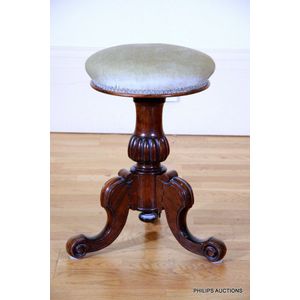Victorian Renaissance Revival Piano Stool with Floral Tapestry Seat
You must be a subscriber, and be logged in to view price and dealer details.
Subscribe Now to view actual auction price for this item
When you subscribe, you have the option of setting the currency in which to display prices to $Au, $US, $NZ or Stg.
- Victorian Period - The Victorian period of furniture and decorative arts design covers the reign of Queen Victoria from 1837 to 1901. There was not one dominant style of furniture in the Victorian period. Designers used and modified many historical styles such as Gothic, Tudor, Elizabethan, English Rococo, Neoclassical and others, although use of some styles, such as English Rococo and Gothic tended to dominate the furniture manufacture of the period.
The Victorian period was preceded by the Regency and William IV periods, and followed by the Edwardian period, named for Edward VII (1841 ? 1910) who was King of the United Kingdom and the British Dominions and Emperor of India for the brief period from 1901 until his death in 1910. - Fluting - A form of decoration found on many pieces of furniture, as well as ceramics, silver and clocks, in which round-bottomed grooves, of varying width and depth, are let into columns, pilasters, legs. As a general rule, flutes are cut in the vertical, though they may follow a turned leg in a spiral pattern. In cross-section, they may be described as a series of 'U' shapes, rising and narrowing at each end of the groove. Fluting is the opposite of reeding, with which fluting is often associated.
- Lion's Paw - The decorative lion's paw has been used in furniture, silver, and ceramics for centuries. It is a stylized representation of the paw of a lion, often depicted in a highly realistic or stylized form.
In furniture design, lion's paws were popular in the neoclassical and Empire styles of the late 18th and early 19th centuries. They were often used as feet on tables, chairs, and other pieces of furniture. The lion's paw was a popular motif for furniture makers because it added a sense of grandeur and regalness to their pieces.
In silverware design, the lion's paw was often used on the feet of tea and coffee pots, as well as on other pieces of silverware such as wine coolers and tureens. The lion's paw was often used in combination with other neoclassical motifs, such as acanthus leaves or grape clusters, to create a sense of grandeur and classical elegance.
In ceramics, lion's paws were commonly used as feet on vases, urns, and other pottery items. The lion's paw was often depicted in relief or as a highly stylized form, and was sometimes used in combination with other decorative elements, such as garlands or swags. - Paw Feet - A paw foot is a base of a furniture leg that resembles the paw of an animal, such as a lion or bear. It is a decorative feature that is often seen in traditional furniture designs, particularly in styles such as Chippendale, Queen Anne, and Georgian. A paw foot typically consists of a carved or moulded ball or disk at the bottom of the leg, which is then carved or shaped to resemble the toes or claws of an animal. The foot may be smooth or textured, depending on the design, and may be finished in a variety of materials, such as wood, metal, or even marble.
Paw feet are often used on heavier pieces of furniture, such as chests, tables, and chairs, to provide additional stability and support. They are also used as a decorative element, adding a touch of elegance and sophistication to the overall design.
"Hairy paw feet" is a term used to describe a variation of the foot design that features a carved or sculpted animal paw, such as a lion or bear, with hair or fur details. The hair or fur details were often carved in a realistic manner and added to the overall decorative effect of the furniture. Hairy paw feet were commonly found on furniture items such as tables, chairs, and cabinets and were popular in the 18th century.
This item has been included into following indexes:
- stools, period or age - Victorian 260
-
stools, type or function
- piano and music 66
- upholstered 322
Visually similar items

A Victorian mahogany tripod based piano stool, 19th century, with maker's mark, Charles Wadman, Bath, no. 6693, with a shaped and reeded pedestal to sweeping legs with whorl feet, the stuffover seat upholstered in sage velvet, height 52 cm

A Victorian mahogany piano stool 47 cm

Royal Worcester Grecian water carrier lamp depicting lady carrying a vessel on her head with an amphora in her right hand on a gilt timber stand with ivory switch, brass light fitting with later glass ball shade. C.1910, height including shade 76 cm

A cedar circular occasional table with platform base and baluster shaped column, circa 1845, 65 cm high, 53 cm diameter
